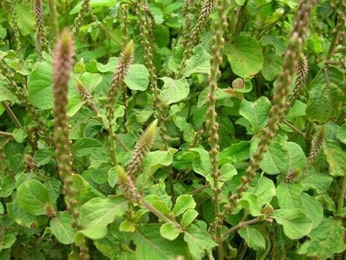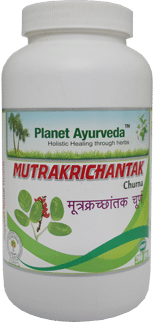Apamarg (Achyranthes Aspera) - Properties, Benefits & Dosage

Achyranthes aspera is small, erect, annual perennial herbs with woody base about 2mt in height. Stems are angular, simple and ribbed with tinged purple color. Leaves are ovate finely attached to stem on both sides. Flowers are greenish white in color and seeds of Apamarg are reddish brown in color subcylindric at apex and rounded at the base.
Ayurvedic texts have given a lot of importance to this herbaceous plant known as Achyranthes aspera. Even cult Ayurvedic texts such as Charaka samhita have named a full chapter after this plant "Apamarg Tanduliya", describing the number of ways it can be used for treating human body.
Apamarg is a notorious plant because its spores catch clothes and are difficult to remove because of the sharp spicules. These spores are actually the fruit part of the plant which grow to cover the whole of the plant stalk from outside acting as a shield of protection for it. It is considered as a very effective herb for detoxification of the body both internally as well as externally.
GENERAL INFORMATION
There are two types of Apamarg available:-
- White Apamarg (shweta) - Achyranthes aspera
- Red Apamarg (rakta) - Puppalia lappaceae
Apamarg is best used in making of special threads (kasharasutra). These threads are used in the treatment of fistula and abscess.
HABITAT
It is a tropical weed distributed throughout tropical world. Apamarg grows in the tropical regions of America, Australia, Asia and Africa. In India it is known for one of the 21 leaves used in the ganesh pooja at ganesh chaturthi. While walking in Indian fields this herb is easily identified because you may feel small fruits with stings that may struck to your legs and dress.
CLASSIFICATION
- Kingdom - Plantae
- Order - Caryophyllales
- Family – Amaranthaceae
NAMES
- English name – Prickly Chaff flower
- Hindi name – Chirchita, Chirchira, Latjira, Chingchingi, Onga
- Sanskrit name – Markati, Markat, Kapi pippali, Parak pushpin, Pratyaka shreni, Mayuraka, Kinihi, Shikhari, Adhah Shalya, Khara manjari, kubja, vasheera, Durabhi graha, Duragraha
- Kannada name – Uttrani, Uttarani
- Telugu Name- Antisha, Apamargamu, Uttaraene
- Malayalam Name- Katalati, Kadaladi
- Bengali Name- Apang
- Punjabi Name- Puthakanda, Kutri
- Marathi Name- Aghada, Pandhara-aghada
- Malagasy Name – Mahabaka
- Tamil Name – Shiru kadaladi, Nayuruvi
- Sinhala – Karal heba
- Indonesia - Jarong
- French name – Herbe à Bengalis, herbe sergen, queue de rat
- Spanish name – Cadillo chichoborugo, cadillo de mazorca, mazotillo
- African name – Grootklits, Langklitskablom
AYURVEDIC PROPERTIES
| Hindi / Sanskrit | English | ||
| Rasa | Katu, Tikta | Taste | Pungent, Bitter |
| Guna | Laghu, Ruksha, Tikshna | Physical Property | Light, Dry, Sharp |
| Virya | Ushna | Potency | Hot |
| Vipaka | Katu | Metabolic Property (After Digestion) | Pungent |
EFFECT ON DOSHA
It balances kapha and vata doshas.
| Charak Samhita | Sushrut Samhita |
| Krimighna – Used to kill microbes and parasites. | Akradi gana |
| Vamnopaga - herbs used in treatment of vamana. | |
| Shirovirechan - Herbs which are good for expelling out dosha from the head / neck. |
ANCIENT VERSE

Apamarg, shikhari, mayurak, markati, durgraha, kinihi, kharamjari are the synonyms of this herb. It is bitter (tikta) and pungent (katu) in taste. It is strong and piercing, stimulate digestive fire (deepana), appetizer and cause vomiting (vaamna). It pacifies vata and kapha dosha. It is used to cure heart diseases (hridyarog), haemmoroids (arsha), itching (kandu), pain (shool) and ascites (udaroga)
SPECIAL ACTIVITY
Apamarg has a special activity in balancing kapha and vata doshas in the body. It has a very effective role in disease where hunger becomes uncontrollable and the condition is known as "Bhasmaka Roga" in Ayurveda.
In such cases, the patients are fed a porridge made from the fruits of Apamarga to satisfy hunger in such patients. The hunger pangs in these patients are so severe (because of highly ignited and exceptionally strong digestive fire) the condition can be compared to hyperacidity as per modern concepts).
PRACTICAL USES OF ACHYRANTHES ASPERA
- Kaphanashana - As described earlier, Apamarga is a very effective and strong detoxifying herb. It is capable of expelling overrunning kapha and vata doshas in the body.
- Virechna - It can be used to induce purgation in patients to help cleanse their doshas.
- Krimighna - Its strong purgative action can help to expel intestinal microbial infections and worm infestations in the gut. When applied externally Apamarg paste can heal wounds, relieve eczema and cleanse any kind of infectious conditions affecting the body.
- Vamana - If one is suffering from uncontrollable vomiting and nausea for a longtime. Apamarg can serve as an indispensable herbal cure.
- Arshoghana - Patients of piles and hemorrhoids can highly benefit from the use of this herb. It keeps the bowels clean and balances kapha and vata doshas that are responsible for inducing constipation and other symptomatic problems which can result in these conditions.
- Deepana and pachna - Apamarg is one of the best herbs to digest "Ama" in the body. Ama has predominant kapha dosha and what better than Apamarg to get rid of this condition. It helps to improve digestive strength and anorexia thereby regularizing the whole natural digestive process.
- Dadruhara and kandu hara - As a general body cleansing effect Apamarg helps to detoxify blood, improve skin condition preventing itching, pruritis and urticaria etc.
- Hridya - It helps to improve cardiac condition by acting on the cholesterol depots that hamper usual blood circulation.
- Apchihara - Women suffering from fibroids and other glandular growths can also get benefit from the use of Apamarg.
- Ahdmanhara - It is also useful to release bloating and distention of stomach.
- Apamarg is an excellent diuretic that helps to breakdown and eliminate renal and urinary bladder stones and any kind of associated infection that may be affecting the person.
- It is one of the best herb for the treatment of kapha and vata disorders affecting the organs above the neck region. There are numerous ways in which it can be put to use to relieve conditions affecting the head region right from migraine to epilepsy, convulsions, psychological problems etc.
EXTERNAL USES OF APAMARG
Root paste of Apamarg is used to cure urticaria, itching and various skin disorders and few drops of Apamarg oil are used to relieve ear pain.
CAUTION
Apamarga should be used with great care as it's over dosage can induce vomiting and nausea.
It is also not safe for pregnant and lactating mothers.
If one is undergoing infertility treatment, then it is better to avoid its use.
DOSAGE
- Fresh juice - 5 – 10ml per day.
- Kshara - 0.5 to 2 g in divided doses per day.
- Apamarg kshara oil - 1-3 drops
PART USED
- Roots
- Seeds
- Leaf
- Panchang
Planet Ayurveda Products that Use this Herb
Mutrakrichantak Churna
Mutrakrichantak Churna is a safe and effective combination of herbs used in Ayurveda since 5000 B.C. for painful urinary conditions and inflammations. It is useful in kidney stones, urinary tract infections, high uric acid, high urea and creatinine levels. These herbs act together in a synergistic manner and are effective in urinary tract infections, ureteric stones and painful micturition. The powder is also recommended in chronic kidney failure and in dialysis patients. It acts as a diuretic while providing natural anti-oxidants and nutrition to the body. Varun and Apamarg are wonderful treatment for prostate enlargement. Shirish is considered in Ayurveda as best anti-allergic. Boerhavia diffusa acts as diuretic with 5 Grassroots. The combination works as a best herbal combination to avoid dialysis due to kidney failure.




